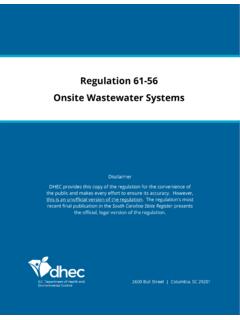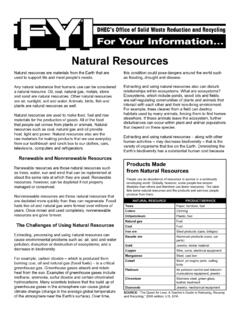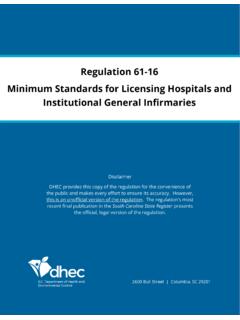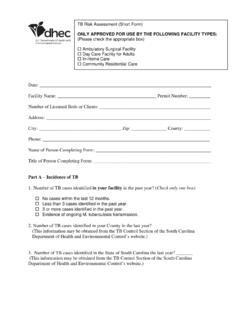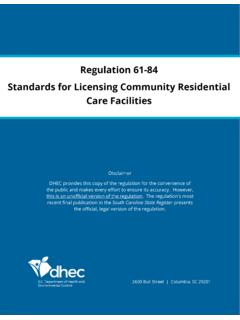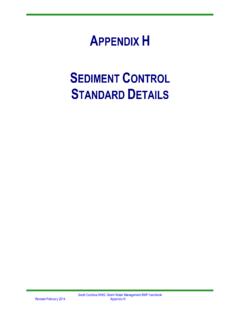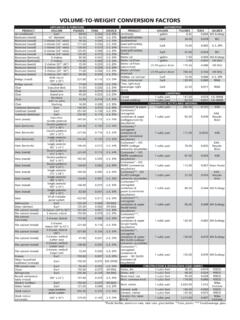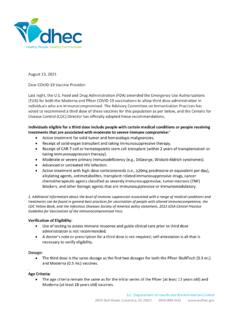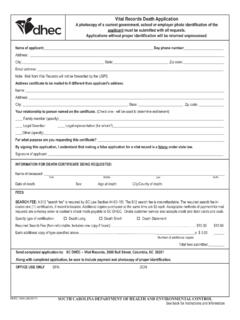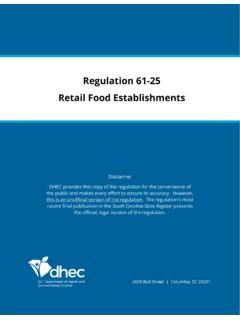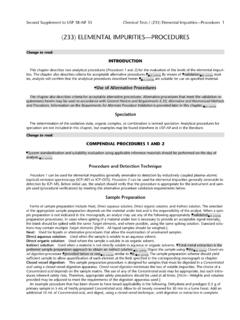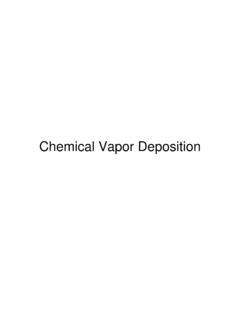Transcription of Procedures for Chain-of-Custody, SOP Development, and ...
1 Page 1 of 29 Procedures for Chain-of-Custody, SOP Development, and Common Field Parameter Measurements (DO, pH, Chlorine, Temperature) Office of Environmental Laboratory Certification March 2018 Page 2 of 29 TABLE OF CONTENTS STANDARD OPERATING Procedures (SOPS) FORMAT .. 3 TRAINING DEMONSTRATION OF CAPABILITY .. 5 PROFICIENCY TESTING (PT) REQUIREMENTS .. 5 CHAIN-OF-CUSTODY .. 6 DISSOLVED OXYGEN (DO) .. 7 HYDROGEN-ION CONCENTRATION (pH) SM 4500H+B-2011 .. 10 RESIDUAL CHLORINE SM 4500Cl G-2011 .. 13 TEMPERATURE - SM 2550B-2010 .. 20 RECORDS AND TRACEABILITY .. 22 REFERENCES .. 22 EXAMPLE RECORDS Thermometer Accuracy Verification Record.
2 23 Temperature Record Chart .. 24 Hydrogen-Ion Concentration (pH) Calibration .. 25 Hydrogen-Ion Concentration (pH) Sample Analysis .. 26 Residual Chlorine Initial Calibration Verification .. 27 Total / Free Residual Chlorine1 Calibration and Sample Analysis .. 28 Dissolved Oxygen Calibration and Sample Analysis for SM 4500 OG-2011 .. 29 Page 3 of 29 STANDARD OPERATING Procedures (SOPS) FORMAT Technical SOPs are written instructions on how to perform a specific analytical method and/or task in the field or laboratory. SOPs are also used to explain how to collect a sample and preserve it to maintain the sample integrity.
3 The SOP must explain all aspects associated with an analysis. More information concerning technical SOPs can be found at Include on the title page and in the header of each SOP the following information: Laboratory Name: Revision Date: SOP ID Number: Revision Number: Issue Date: Use the following format for developing a technical SOP: Parameter Name EPA Approved Method Reference A. Scope and Applicability Describes the purpose of the process or procedure, types of samples analyzed, and any organization or regulatory requirements, as well as any limits to the use of the procedure. B. Summary of the Method Provides a brief explanation of the procedure.
4 C. Definitions Defines any acronyms, abbreviations, or specialized terms used in the methodology and SOP. D. Health & Safety Includes operations and/or chemicals that could result in personal injury or loss of life and explains what will happen if the procedure is not followed or is followed incorrectly. E. Interferences Describes any component of the process that may interfere with the accuracy of the final product. Includes physical or chemical properties of the sample. F. Sample Handling, Preservation, and Storage Documents the sampling and collection requirements for each type of sample (NPDES, Drinking Water, and Solid and/or Hazardous Waste).
5 Specifies the maximum required holding time from the time of collection along with the temperature and chemical preservative. Documents the storage conditions for sample analysis. G. Instrumentation and Equipment Lists all instrumentation and equipment that are necessary to perform the analysis/test. Specifies the manufacturer and model number of all instruments. Page 4 of 29 H. Reagents, Standards, and Consumable Materials Lists all reagents, standards, and materials needed to perform the analysis/test. Specifies the source by documenting the manufacturer, catalog number, concentration, and any other pertinent information.
6 I. Standard and/or Reagent Preparation Documents the preparation procedure for all standards and reagents. Specifies the concentration at which all standards and/or reagents are prepared and the storage conditions and maximum holding times for all standards and reagents. Specifies the procedure for necessary standardization of reagents and the frequency performed. J. Instrument Calibration Procedures Documents the calibration Procedures and frequency of calibration for each instrument. Includes initial calibration and calibration verification Procedures along with the acceptance criteria for a valid calibration.
7 K. Sample Analysis Procedures Documents step-by-step Procedures for analyzing routine and quality control samples. L. Quality Control Includes all laboratory quality control practices along with the frequency and acceptance criteria for all QC samples and calibration verifications. Describes the initial Demonstration of Capability (DOC) and on-going demonstration of capability for all analysts. Includes the Procedures for the determination of Method Detection Limits (MDLs), if applicable. M. Data Reduction, Validation, and Reporting Describes data reduction, calculations, and reporting Procedures . N. References Includes the references used to develop the SOP and any pertinent instrument manuals.
8 O. Waste Management Provides information concerning proper waste disposal Procedures for samples and/or reagents and supplies. P. Revision History Documents the section(s) that have been modified since the last revision. Provides an ongoing history of the SOP modifications. The revision history should include the following information: SOP Revision # Revision Date Section Modified Modification Reason Changed Q. Appendix Include all appendices, tables, diagrams, etc. Page 5 of 29 TRAINING DEMONSTRATION OF CAPABILITY Training records must be maintained for all personnel. These records should include all job-related formal education and training taken by the analyst that pertains to any aspect to his/her responsibilities, including but not limited to analytical methodology, SOP review, laboratory safety, sampling, quality assurance, and data analysis.
9 An initial demonstration of capability (IDOC) must be performed for each method and each analyst. It is a demonstration of the precision and accuracy required by the method. As stated in SM , each analyst must conduct an IDOC at least once before analyzing any sample to demonstrate proficiency in performing the method and obtaining acceptable results for each parameter . An ongoing or continuing demonstration of capability (CDOC) is used to document an analyst s continued proficiency with a method by meeting the precision and accuracy requirements. (Refer to SM for guidance) PROFICIENCY TESTING (PT) REQUIREMENTS Proficiency Testing Requirements can be found on our website at The required proficiency testing parameters are also specified.
10 If you have any questions, contact the Office of Environmental Laboratory Certification at (803)896-0970 or by email at Page 6 of 29 CHAIN-OF-CUSTODY Each certified laboratory must have written instructions for sample collection and handling in its standard operating Procedures manual. To ensure sample integrity, it is required that an accurate written record (chain-of-custody) be available to trace the possession and handling of samples from the moment of collection through analysis and final disposition. This is referred to as chain-of-custody and is important to ensure sample integrity and will be used in the event of litigation involving the sample results.
